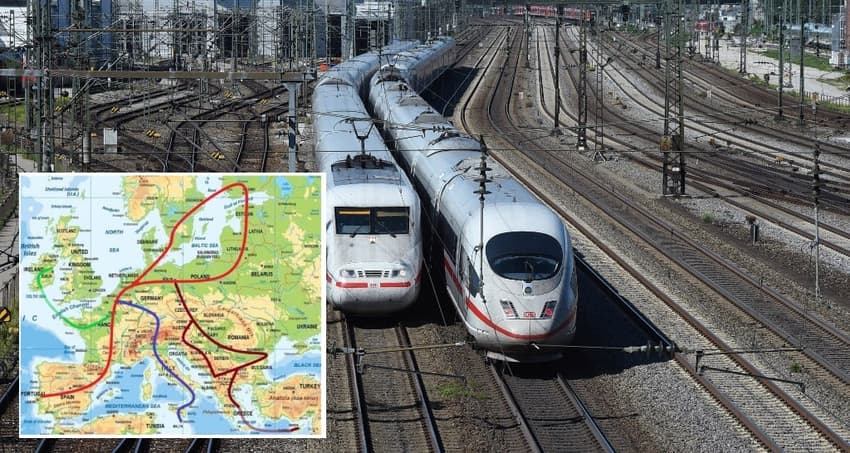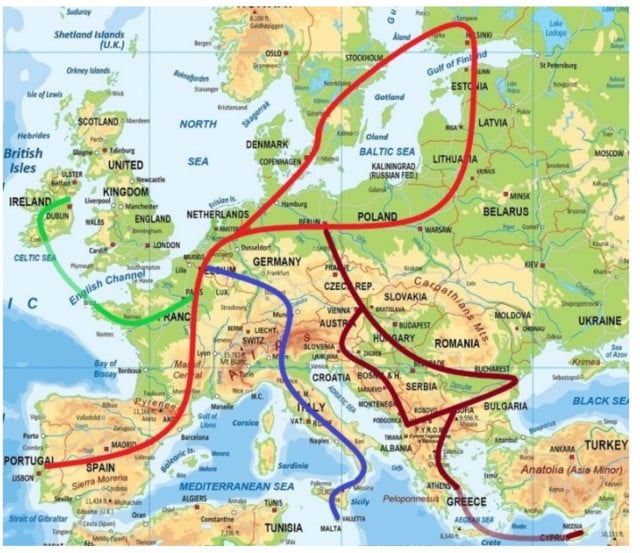Direct link from Sicily to Brussels on proposed European ultra-rapid train network

The EU's coronavirus economic recovery package could be used to fund an ultra-rapid train line through Italy, creating a direct rail connection to Brussels.
The EU's €2 trillion recovery package for economies blighted by the coronavirus pandemic and the subsequent lockdown aims to avoid a damaging and long-lasting recession.
READ ALSO:
It proposes helping out industries particularly badly hit by the lockdown, such as tourism.
And a report from the Vienna Institute for Economic Studies looking at ways of spending the fund to give the greatest benefit also suggests a series of massive infrastructure projects including a European ultra-rapid train network.
The document proposes "a European green high-speed train network to be established as part of a recovery programme from the Covid-19 crisis over the period of the 2020s. Map: Vienna Institute for International Studies.
Map: Vienna Institute for International Studies.
It includes a line running the length of Italy, running from Brussels down to the Maltese capital Valetta.
The line could connect underdeveloped regions of southern Italy with Switzerland, Germany, and Belgium, as well as potentially halving current journey times between northern and southern Itaian cities.
"A fully fledged URT network might consist of four major railway lines, connecting all the capital cities of the EU. Equally it connects many of Europe’s key economic powerhouses, but also less developed regions, such as the Mezzogiorno (southern Italy)" it stated.
The plan proposes four lines.
1. Paris to Dublin - from Paris to Brest, taking the Brest-Cork ferry then running from Cork to Dublin. The report describes this route as 'taking on an additional significance in the context of Brexit'.
2. Lisbon to Helsinki - running from Lisbon through Spain and France, via Paris, then to Belgium and the Netherlands before splitting into a loop via Berlin and onwards to Helsinki.
3. Brussels to Valetta - through Belgium, Germany, Switzerland and Italy before taking the ferry to Malta
4. Berlin to Nicosia - with a ferry-based sea link between Piraeus and Paphos and a loop between Vienna and Sofia.
"The URT network should be a new double-track high-speed railway system that is complementary to the existing networks."
READ ALSO:
However, where suitable, also existing lines could be adapted. An average speed in the range of 250-350 km/h should be achieved."
"This would allow passengers to halve the current rail travel times, for instance, from Paris to Berlin in about four hours, making air travel for a large part of the intra-European passenger transport obsolete.
"Cutting by around half the EU’s domestic air passenger operations has the potential to reduce global commercial aviation CO2 emissions by about 4-5 percent. In addition, rail cargo capacities would be increased, freight transport speeded up and so also road-vehicle emissions reduced."
The plan would represent a major rail infrastructure building project in Italy, creating some 2,254 kilometres of track - the second highest of any country included in the project after Germany, which would create an extra 2,299km.
Comments
See Also
The EU's €2 trillion recovery package for economies blighted by the coronavirus pandemic and the subsequent lockdown aims to avoid a damaging and long-lasting recession.
READ ALSO:
It proposes helping out industries particularly badly hit by the lockdown, such as tourism.
And a report from the Vienna Institute for Economic Studies looking at ways of spending the fund to give the greatest benefit also suggests a series of massive infrastructure projects including a European ultra-rapid train network.
The document proposes "a European green high-speed train network to be established as part of a recovery programme from the Covid-19 crisis over the period of the 2020s. Map: Vienna Institute for International Studies.
Map: Vienna Institute for International Studies.
It includes a line running the length of Italy, running from Brussels down to the Maltese capital Valetta.
The line could connect underdeveloped regions of southern Italy with Switzerland, Germany, and Belgium, as well as potentially halving current journey times between northern and southern Itaian cities.
"A fully fledged URT network might consist of four major railway lines, connecting all the capital cities of the EU. Equally it connects many of Europe’s key economic powerhouses, but also less developed regions, such as the Mezzogiorno (southern Italy)" it stated.
The plan proposes four lines.
1. Paris to Dublin - from Paris to Brest, taking the Brest-Cork ferry then running from Cork to Dublin. The report describes this route as 'taking on an additional significance in the context of Brexit'.
2. Lisbon to Helsinki - running from Lisbon through Spain and France, via Paris, then to Belgium and the Netherlands before splitting into a loop via Berlin and onwards to Helsinki.
3. Brussels to Valetta - through Belgium, Germany, Switzerland and Italy before taking the ferry to Malta
4. Berlin to Nicosia - with a ferry-based sea link between Piraeus and Paphos and a loop between Vienna and Sofia.
"The URT network should be a new double-track high-speed railway system that is complementary to the existing networks."
READ ALSO:
However, where suitable, also existing lines could be adapted. An average speed in the range of 250-350 km/h should be achieved."
"This would allow passengers to halve the current rail travel times, for instance, from Paris to Berlin in about four hours, making air travel for a large part of the intra-European passenger transport obsolete.
"Cutting by around half the EU’s domestic air passenger operations has the potential to reduce global commercial aviation CO2 emissions by about 4-5 percent. In addition, rail cargo capacities would be increased, freight transport speeded up and so also road-vehicle emissions reduced."
The plan would represent a major rail infrastructure building project in Italy, creating some 2,254 kilometres of track - the second highest of any country included in the project after Germany, which would create an extra 2,299km.
Join the conversation in our comments section below. Share your own views and experience and if you have a question or suggestion for our journalists then email us at [email protected].
Please keep comments civil, constructive and on topic – and make sure to read our terms of use before getting involved.
Please log in here to leave a comment.